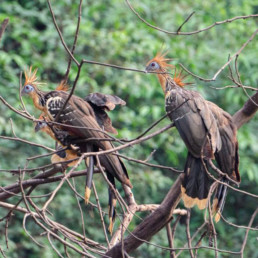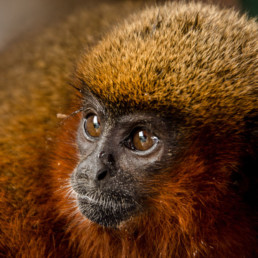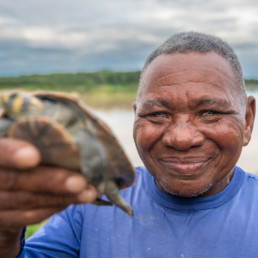Goal
Conservation success within tropical forest is dependent on the alignment between science, local ecological knowledge and engagement of indigenous people and local communities. This project will strengthen and expand the community-based protection of fluvial beaches and floodplain lakes, to ensure the conservation of the aquatic biodiversity. Beyond the conservation outcomes, this project will also ensure capacity building for indigenous people and local communities which are the main actors ofthe Amazon conservation.

Field Partner
Instituto Juruá is a Brazilian non-profit organization formed by conservationists, researchers and local environmental leaders in close partnership with rural communities and local associations. They provide financial and technical support for community-based initiatives of natural resource management, and offer capacity building opportunities for local communities to help them sustainably manage their natural resources and protect their territory. Their mission is to combine cutting-edge scientific research and traditional local knowledge to support positive initiatives for the use and management of natural resources across the Amazon, in order to promote biodiversity conservation, food security, health and income for indigenous and non-indigenous people.
Location
Jurua River in the Brazilian Amazon. This project will target 20 new floodplain lakes and 20 fluvial beaches. Eventually the model will operate in ~2,500 km of Jurua River, integrating local communities from different levels of local governance. This arrangement will ensure the protection of ~300 floodplains lakes and ~45 fluvial beaches.


Maps data © 2024 Google

It is hoped that this model of river basin conservation program in Amazonia that can ensure the alignment of biodiversity protection and improvements of local well-being will be expanded to other river-basins across the Brazilian Amazonia.
The pulse of the river
The Juruá River is arguably the most meandering tributary of the Amazon River, and irrigates one of the most complex floodplain systems on Earth. It is ~3,500 km long within Brazil alone, and its floodplain features are highly complex with thousands of an astonishing floodplain várzea channels (= paranãs) linking both aging and recent oxbow lakes, which support hugely important freshwater fisheries for both local communities and a high biomass of piscivorous vertebrates. The Juruá region comprises vast expanses of seasonally flooded (várzea, VZ) forest along the floodplain of the Juruá river and adjacent terra firme (TF) forest farther inland. Located within a megadiverse region of Western Brazilian Amazonia, the project area provides key habitats for many species of terrestrial fauna which make regular seasonal incursions into várzea forest from the adjacent terra firme forest to take advantage of abundant plant resources provided by the spectacular annual flood pulse.
Life on the River's Edge
Sand beaches along the main course of the river ensure the reproduction of many important threatened or otherwise historically overexploited species, including freshwater turtles such as the South American River Turtle, Yellow-spotted River Turtle, and Six-tubercled Amazon River Turtle. These fluvial beaches also support important breeding populations of several key migratory waterbird species, including the Orinoco Goose, Black Skimmer, Large-Billed Tern and other transcontinental migrants such as sandpipers and Osprey. The many oxbow lakes in the prospective project area provide critical habitat for the reproduction of several key fish species including pirarucu and feeding sites for turtle hatchlings as well as numerous waterbirds. Other large aquatic vertebrates that will be protected by our project area include Black Caiman, Amazonian Manatee, Giant Otter, and Amazon river dolphin.
The Remarkable Recovery of Arapaima Gigas Population
Contrary to the doom-and-gloom narrative in conservation science, the Jurua is scene to some promising community-based conservation (CBC) arrangements, where local people play a positive role in biodiversity conservation. CBC initiatives are emerging as a powerful tool to recover and maintain populations of several historically overexploited species throughout the Amazon basin, including Arapaima and Freshwater Turtles.
Instituto Juruá’s previous research has helped develop a highly successful initiative integrating both conservation and local livelihoods through a community-based fishery management (CBFM) scheme targeting the giant arapaima (Arapaima gigas). The arapaima is the world’s largest scaled freshwater fish and was dramatically overfished in the last century, but now there is strong evidence for population recovery within CBFM areas, especially in the Juruá River catchment. In this management model, local communities are legally empowered to protect their fishing grounds (oxbow lakes) against large-scale commercial fisheries through an official document called a “Fishing Agreement”. During the dry season, oxbow lakes are discrete units in the landscapes and can be monopolized.
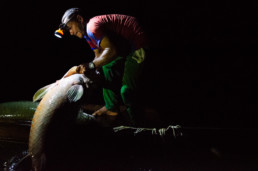
Fishing Agreements effectively secure the establishment of three categories of lake management:
- Open access lakes are available for exploitation by commercial fisheries that are generally uncontrolled;
- Subsistence-use lakes allow access only for fisherfolk from the community directly responsible for the lake — the main purpose of this category is to supply food for the community;
- Strictly protected lakes are ‘no-take’ lakes designed to ensure the reproduction of the target species. Fisheries are not permitted, apart from a sustainable off-take during a short period once each year based on a strict harvest quota. Adapted to hypoxic environments, arapaima regularly come to the surface to breathe, which facilitates direct population counts and stock assessments to set sustainable harvest quotas. These lakes are guarded by the local community over the entire year.
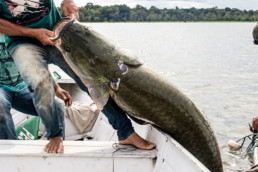
Arapaima gigas, also known as pirarucu
Previous dry-season surveys show that protected lakes contain an arapaima population up to 50-fold higher than in unprotected lakes, and over the last 12 years, wild arapaima populations have
demonstrated an impressive recovery trend, increasing by 425%. During the wet season, when the floodplains are inundated, arapaima can migrate across the landscape, but they return to protected lakes in the dry season, showing high site fidelity. In addition to the conservation benefits for this iconic Amazonian fish, arapaima management has also emerged as a great window of opportunity to improve the welfare of rural people. Sale of sustainably harvested fish from protected lakes provides an average revenue of US$ 9,000/year per lake and these funds have been used to improve access to health and education and to re-invest in infrastructure for further development of the management programme. This has encouraged enthusiastic participation by entire communities, including women, fostered cooperation between remote rural communities, and strengthened regional associations. Due to its strong social and ecological outcomes and its potential to be replicated, the CBFM of giant arapaima has been increasingly recognized as one of the most promising sustainable activities to tackle conservation, food security and poverty across Amazonia.
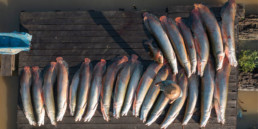
Landing for transportation to the pirarucu loading port managed at Lake Serrado
Bridging Conservation and Livelihoods
In the same geographic area, community-based conservation of freshwater turtles is also ensuring the population recovery of the Giant River Turtle, which increased over nine-fold during the last 40 yrs. The community-protection of fluvial sand beaches also benefit a wide range of other beach-nesting freshwater species, including migratory and resident birds, catfishes, green iguanas and invertebrates. However, this ICDP model still lacks tangible socioeconomic benefits, and the creation of innovative mechanisms to deliver direct or indirect financial compensation for local beach guards, who protect fluvial beaches (on a 24-by-7 basis) during the nesting season. CBC initiatives therefore provide a source of optimism for the protection of threatened Amazon floodplains and their charismatic megafauna, but it still needs a solid strategy to be strengthened and expanded. In this proposal we bring a set of activities to inform and support the expansion of community-based protection for fluvial beaches and floodplain lakes across ~2,000 km along the Juruá River, which can provide a flagship example for the first basin-wide conservation model led by local communities. Our proposal is based on two complementary pillars: Territorial protection and capacity building of indigenous people and local communities.
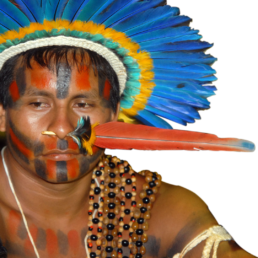
Unrecognized and Vulnerable: Challenges Facing the Kulina
The Kulina people belong to the Arawá linguistic family and, until the arrival of the colonizers, were one of the most numerous groups in the state of Acre and southern Amazonas. Their self denomination is madija which means “those who are people”;, with colonizers generally addressed as Cariás. The first regular contacts of the Kulina with the colonizers took place with the rubber tappers in the rubber boom at the end of the 19th century, when they lived deep in the forest. Due to the violent incursions promoted by Brazilian rubber tappers, they fled towards the headwaters of rivers in the region. At Juruá river, the Kulina people from Eré river, a tributary of Juruá River, are a very neglected people who still do not have their territory recognized as an indigenous land. The lack of territory recognition induces a
wide range of conflicts in their lands due to illegal fisheries, hunting and poaching activities. Last year Instituto Juruá started to work with this group by strengthening their social organization towards an official recognition of their territory.



